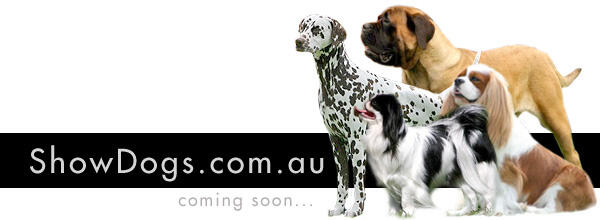
A BEGINNERS GUIDE TO CONFORMATION DOG SHOWING IN AUSTRALIA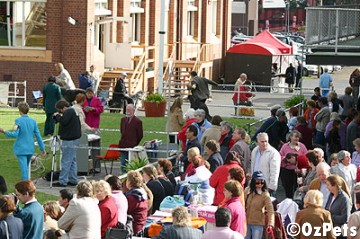 If you have recently purchased a purebred dog then why not have some fun and enter a few dog shows. It's a good day out and a chance to meet people with similar interests and learn more about your breed. Your breeder should advise you how to register your dog with your state controlling canine body otherwise the relevant contact details are listed below.
If you have recently purchased a purebred dog then why not have some fun and enter a few dog shows. It's a good day out and a chance to meet people with similar interests and learn more about your breed. Your breeder should advise you how to register your dog with your state controlling canine body otherwise the relevant contact details are listed below.
A pure bred dog registered with your State Controlling body can be shown in the numerous dog shows held throughout Australia.
Getting Started :
Once you have registered your dog and have a copy of the latest show schedule you can enter a show. There are different types of conformation shows held :
Types of Dog Shows :
Championship Show : - a show where dogs are competing for challenge certificate. A challenge certificate verifies the number of points a dog has won at the particular event. These points go towards the dogs Australian Champion title. Both the best dog and bitch of a breed are awarded with a challenge certificate. Champions and non-champion dogs are eligible to compete. Only qualified judges officiate.
Open Show :- a show where no challenge points are awarded. Both champions and non-champions can compete. Trainee judges officiate. These shows are recommended as a starting point for training new dogs and new owners.
Parade :- This is the same as an open show, however Champions can not compete.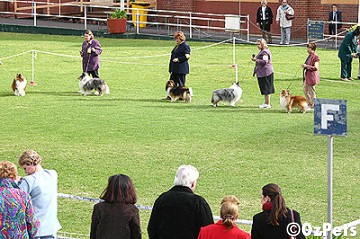 Groups :
Groups :
All purebred dogs fall into a specific group, recognised by the Australian National Kennel Council. The following lists all recognised breeds in their relevant group.
Group 1 (Toys) - Affenpinscher, Australian Silky Terrier, Bichon Frise, Cavalier King Charles Spaniel, Chihuahua (Long Coat), Chihuahua (Smooth Coat), Chinese Crested Dog, English Toy Terrier (Black & Tan), Griffon Bruxellois, Havanese, Italian Greyhound, Japanese Chin, King Charles Spaniel, Lowchen, Maltese, Miniature Pinscher, Papillon, Pekingese, Pomeranian, Pug, Tibetan Spaniel, Yorkshire Terrier.
Group 2 (Terriers) - Airedale Terrier, American Staffordshire Terrier, Australian Terrier, Bedlington Terrier, Border Terrier, Bull Terrier, Bull Terrier (Miniature), Cairn Terrier, Cesky Terrier, Dandie Dinmont Terrier, Fox Terrier (Smooth), Fox Terrier (Wire), Glen of Imaal Terrier, Irish Terrier, Jack Russell Terrier, Kerry Blue Terrier, Lakeland Terrier, Manchester Terrier, Norfolk Terrier, Norwich Terrier, Parson Russell Terrier, Scottish Terrier, Sealyham Terrier, Skye Terrier, Soft Coated Wheaten Terrier, Staffordshire Bull Terrier, Welsh Terrier, West Highland White Terrier.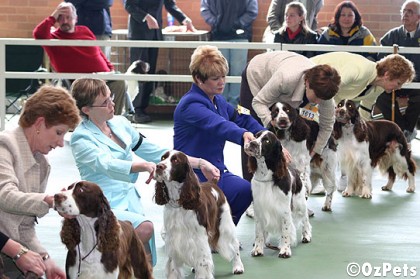 Group 3 (Gundogs) - Brittany, Chesapeake Bay Retriever, Clumber Spaniel, Cocker Spaniel, Cocker Spaniel (American), Curly Coated Retreiver, English Setter, English Springer Spaniel, Field Spaniel, Flat Coated Retriever, German Shorthaired Pointer, German Wirehaired Pointer, Golden Retriever, Gordon Setter, Hungarian Vizsla, Irish Setter, Irish Red & White Setter, Irish Water Spaniel, Italian Spinone, Labrador Retriever, Large Munsterlander, Nova Scotia Duck Tolling Retriever, Pointer, Sussex Spaniel, Weimaraner, Weimaraner (Longhair), Welsh Springer Spaniel.
Group 3 (Gundogs) - Brittany, Chesapeake Bay Retriever, Clumber Spaniel, Cocker Spaniel, Cocker Spaniel (American), Curly Coated Retreiver, English Setter, English Springer Spaniel, Field Spaniel, Flat Coated Retriever, German Shorthaired Pointer, German Wirehaired Pointer, Golden Retriever, Gordon Setter, Hungarian Vizsla, Irish Setter, Irish Red & White Setter, Irish Water Spaniel, Italian Spinone, Labrador Retriever, Large Munsterlander, Nova Scotia Duck Tolling Retriever, Pointer, Sussex Spaniel, Weimaraner, Weimaraner (Longhair), Welsh Springer Spaniel.
Group 4 (Hounds) - Afghan Hound, Australian Dingo, Basenji, Basset Fauve de Bretagne, Basset Hound, Beagle, Bloodhound, Bluetick Coonhound, Borzoi, Dachshund (Long Haired), Dachshund (Min. Long Haired), Dachshund (Smooth Haired), Dachshund (Min. Smooth Haired), Dachshund (Wire Haired), Dachshund (Min. Wire Haired), Deerhound, Finnish Spitz, Foxhound, Greyhound, Hamiltonstovare, Harrier, Ibizan Hound, Irish Wolfhound, Norwegian Elkhound, Otterhound, Petit Basset Griffon Vendeen, Pharaoh Hound, Rhodesian Ridgeback, Saluki, Sloughi, Whippet.
Group 5 (Working Dogs) - Australian Cattle Dog, Australian Kelpie, Australian Shepherd, Bearded Collie, Belgian Shepherd Dog (Groenendael - Laekenois - Malinois - Tervueren), Border Collie, Bouvier des Flandres, Briard, Collie (Rough), Collie (Smooth), Finnish Lapphund, German Shepherd Dog, Komondor, Kuvasz, Maremma Sheepdog, Norwegian Buhund, Old English Sheepdog, Polish Lowland Sheepdog, Puli, Pumi, Shetland Sheepdog, Stumpy Tail Cattle Dog, Swedish Vallhund, Welsh Corgi (Cardigan), Welsh Corgi (Pembroke).
Group 6 (Utility Group) - Akita, Alaskan Malamute, Anatolian Shepherd Dog, Bernese Mountain Dog, Black Russian Terrier, Boxer, Bullmastiff, Central Asian Shepherd Dog, Dobermann, Dogue de Bordeaux, German Pinscher, Kangal Dog, Leonberger, Mastiff, Neapolitan Mastiff, Newfoundland, Portugese Water Dog, Pyrenean Mountain Dog, Rottweiler, Samoyed, Schnauzer, Schnauzer (Min.), Schnauzer (Giant), Shiba Inu, Siberian Husky, St. Bernard, Tibetan Mastiff.
Group 7 (Non-Sporting) - Boston Terrier, British Bulldog, Canaan Dog, Chow Chow, Dalmatian, Eurasier, French Bulldog, German Spitz (Mittel & Klein), Great Dane, Japanese Spitz, Keeshond, Lagotto, Lhasa Apso, Poodle (Standard), Poodle (Min), Poodle (Toy), Schipperke, Shar Pei, Shih Tzu, Tibetan Terrier.
Classes :
The shows are divided into various classes, the following are offered at the majority of shows held:
Class 1. Baby Puppy - 3-6 months old
Class 2. Minor Puppy - 6-9 months old
Class 3. Puppy - 6-12 months old
Class 4. Junior - 9-18 months old
Class 5. Intermediate - 18-36 months old
Class 11. Open - dogs over 6 months old
(usually consists of dogs over 3 years)
Other classes include :
Class 6. Novice - dogs over 6 months that have not won a first prize at an Open or Championship show.
Class 7. Graduate - dogs over 6 months that have not won a Challenge Certificate.
Class 8. Limit - dogs over 12 months, which are not Champions.
Class 9. State Bred - dogs over 6 months breed in the state it is being exhibited.
Class 10. Australian Bred - dogs over 6 months bred in Australia.
Class 21. Champion - For all Champions entered in an Open Show
Dogs are entered as (1) (2) etc.
Bitches are entered as (1a) (2a) etc.
To Enter :
On the show schedule you will see the type of show, classes, location, entry fees, date of show, judge and typically the host clubs secretary contact details. You will need to complete an official entry form (obtainable from your State Controlling Body) and send to the secretary along with the show entry fees and a stamped self addressed envelop. Completing the entry form is fairly straight forward - you must enter the dogs registered name and number, sire and dam, date of birth, sex, breeder name, your details as the owner and your membership number and the group and class you wish to enter. Group and class details are as above, for example if you have a 3 month old Boston Terrier dog (male) it would be entered in Group 7, Class 1.
If you need help completing the entry form I would suggest contacting your breeder, the State Controlling Body or even the show secretary is usually willing to help.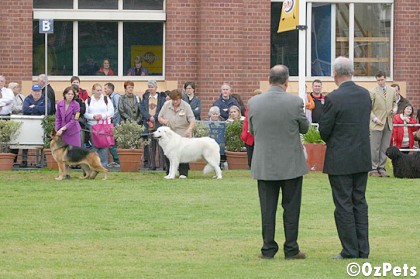 Show Day :
Show Day :
By now you will have received your exhibit number by return mail and if not this can be collected from the show secretary's office on the day. Make sure you double check judging times in the show schedule and allow plenty of time to get to the venue. You will probably notice your breed beside a ring, that is probably where your ring is, otherwise ask a steward where your ring is and position yourself nearby. Then wait for your exhibit number to be called.
In the meantime exercise your dog and get some practice in the practice areas available. Also speak to other exhibitors and breeder they are always willing to offer some friendly advice.
Judging :
The dogs are shown first then the bitches are shown in order of class (1,2,3 etc.). So the baby puppies dogs are up first followed by minor puppy dogs, puppy dogs and so on. The best dog is selected at the conclusion of judging all dogs and the best bitch is selected at the conclusion of all bitches. The best dog and best bitch then compete for best in breed and the runner up dog or bitch is requested back in the ring in order to select the runner up best of breed. Once this is done it is followed by the respective "run-offs" between the class winners in dogs and bitches for Best Baby Puppy of Breed, Best Minor Puppy of Breed, Best Puppy of Breed etc.
On conclusion of all breed judging in a group all Best of Breeds are requested in to the ring in order to select the Best Exhibit in Group. Once the Group winner is selected their runner up in breed is then requested back in the ring in order to pick the runner up Best Exhibit in Group.
Following this is Best Baby Puppy in Group, Best Minor Puppy of Group etc. So if you did win Best Baby Puppy of Breed don't go home until the group judging's are over. You never know you may win Best Baby Puppy in Group.
Once all of the Best in Groups are selected a Best Exhibit in Show is selected and runner up to Best Exhibit in Show. Again all Best of Groups winners are required to be judged for Best in Show placings. So if you have won Best Baby Puppy in Group you will be then judged for Best Baby Puppy in Show competing against all other Group winners.
You're Hooked you want to achieve an Australian Champion Title :
Once you've got through your first few shows you'll probably find that you enjoy it so much you can't stop. You want to achieve an Australian Champion title with your dog so you start showing at more Championship Shows in order to gain valuable points.
The total points required for an Australian Championship title is 100. If you are awarded the Best Dog or Bitch of breed you will be issued with the Challenge Certificate verifying how many points you have earned towards your title. Points are given subject to the number of dogs shown. The calculation is 5 points plus one point for every dog shown. E.g. If there is only one dog or bitch shown the challenge would be 6 points, if there are 8 dogs and 6 bitches the dog challenge would be 13 points and the bitch challenge 11 points. If the dog is then awarded Best of Breed he would earn the points for all opposite sex exhibits, therefore he would be awarded 19 points. The maximum number of points that can be earned at any one show is 25 so generally Best in Group and Best in Show are awarded 25 point challenge certificates.
Once you have your 100 challenge points you must apply with your controlling body for an Australian Champion Certificate.
A dog who achieves 1000 points is entitled to The Australian Grand Champion Title. *Note that at least one of these Challenge Certificates had to be won on or after 1st January, 1998.
A Very Special Conclusion :
Always have fun and enjoy yourself. Don't be disappointed if your dog doesn't win, it doesn't mean they are any less of a dog and loyal friend. I have shown dogs on and off for 19 years and had both winners and losers and they are all as valuable and special as each other. Obviously it is very exciting to win but never expect to win and don't worry if you don't. The most important thing is to take care of your dog and be a responsible owner.